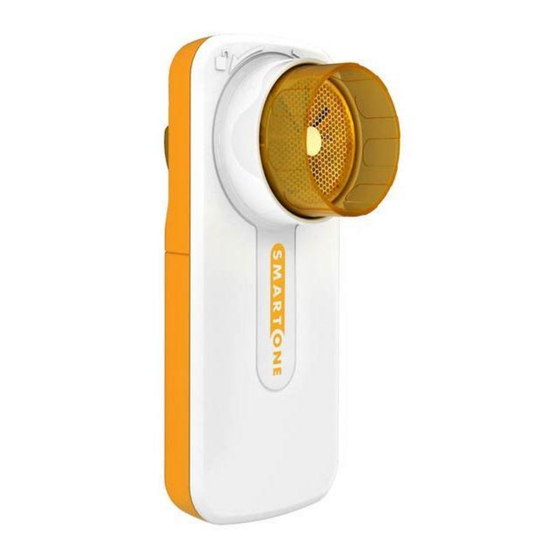
Summary of Contents for MIR SmartOne
- Page 1 SmartOne User manual SmartOne User manual rev. 0.1 Issue date 05.01.2015 Approval date 05.01.2015 DRAFT VERSION Rev.0.1 Page 1 of 17...
-
Page 2: Table Of Contents
SmartOne User manual INDEX INTRODUCTION ......................................3 Intended Use ......................................3 1.1.1 User Category ...................................... 3 1.1.2 Ability and experience required ............................... 4 1.1.3 Operating environment ..................................4 1.1.4 Subject effect on the use of the device ............................4 1.1.5 Limitations of use - Contraindications ............................ -
Page 3: Introduction
Thank you. MIR accepts no responsibility for any loss or damage caused by the User of the device due to the use of this Manual and/or due to an incorrect use of the product. -
Page 4: Ability And Experience Required
SmartOne User manual 1.1.2 Ability and experience required The correct use of the device, the interpretation of the results and the maintenance of the device, with particular attention to disinfection (cross-contamination risk), all require qualified personnel. WARNING The manufacturer cannot be held responsible for any damage caused by the user of the device failing to follow the instructions and warnings contained in this manual. -
Page 5: Danger Of Cross-Contamination
SmartOne User manual turbine flow sensor and oximetry sensor or other accessories may cause errors in measurement and/or compromise the correct functioning of the device, and is therefore not permitted. In the event of any incident or accident of any kind resulting from the use of the device, the user is required to inform the manufacturer without delay, according with Directive 93/42/EEC on Medical Devices. -
Page 6: Mouthpiece
All applicable local regulations must be followed. If any of these rules are not followed then MIR will decline all responsibility for any direct or indirect damages, however caused. -
Page 7: Identification Label
SmartOne User manual 1.4.1 Identification label The label shows: Serial number of the device Product name Name and address of the manufacturer Electrical safety symbol Warning symbol for the WEEE Directive Mark of conformity with the Medical Device Directive 1.4.2... -
Page 8: Technical Features
SmartOne User manual The main features of this multipurpose Smart One® make it is easy to use and versatile. Spirometry function Smart One ® calculates up to 30 functional respiratory parameters, as well as the parameter comparison after the administration of a drug (PRE/POST) for a bronchodilator test or for a bronchial challenge test. -
Page 9: Other Features
SmartOne User manual Measured parameters: SYMBOL DESCRIPTION m.u. Forced Vital Capacity FEV1 Volume expired in the 1 second of the test FEV1% FEV1/FVC x100 FEV3 Volume expired in the initial 3 seconds of the test FEV3/FVC FEV3/FVC x 100 FEV6... -
Page 10: Functioning Of The Smart One
SmartOne User manual Humidity: MIN 10% RH; MAX 95%RH Electrical Safety Standard IEC 60601-1 Compliance with standards EMC Standard IEC 60601-1-2 Type of electrical protection Class II Grade of electrical protection Grade of protection against water IPX0 ingress Level of safety in the presence of... - Page 11 SmartOne User manual normal mild moderate moderately severe severe very severe Through an analysis applied to some of the indices and parameters calculated in the FVC test, Smart One® produces a variety of quality control comments useful to understand the reliability of the test made.
-
Page 12: Maintenance
Do not put the turbine under a direct jet of water or other liquid. If no detergent solution is available, clean the turbine in clean water. MIR suggest the use of Perasafe, manufactured by Dupont, which has been tested with positive results on all MIR sensors. - Page 13 SmartOne User manual Rev.0.1 Page 13 of 17...
- Page 14 DECLARATION OF CONFORMITY CE (annex II excluding par.4) We hereby declare that the following device: Type Spirometer Brandname MIR Medical International Research ® Device name Smart One Class Complies with the Essential Requirements of directive 93/42/EC concerning Medical Devices, and its amendments, and its transposition in the Member States.
- Page 15 MIR. MIR Medical International Research, reserves the right to modify the instrument if required, and a description of any modification made will be sent along with the returned goods.
-
Page 16: Annex 1 Information For Correct Use In Electromagnetic Environments
SmartOne User manual ANNEX 1 INFORMATION FOR CORRECT USE IN ELECTROMAGNETIC ENVIRONMENTS Guidance and manufacturer’s declaration – electromagnetic emissions The Smart One® is intended for use in the electromagnetic environment specified below. The customer or the user of the Smart One® should assure that it is used in such an environment. - Page 17 SmartOne User manual IEC 61000-4-3 80 MHz to 2,5 GHz should be less than the compliance level in each frequency range.b Interference may occur in the vicinity of equipment marked with the following symbol: NOTE 1 At 80 MHz and 800 MHz, the higher frequency range applies.
- Page 18 SmartOne User manual FCC RF Exposure Information and Statement This equipment complies with FCC RF radiation exposure limits set forth for an uncontrolled environment. This device complies with part 15 of the FCC rules. Operation is subject to the following two conditions: (1) this device may not cause harmful interference, and (2) this device must accept any interference received, including interference that may cause undesired operation.
















Need help?
Do you have a question about the SmartOne and is the answer not in the manual?
Questions and answers